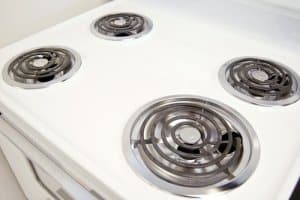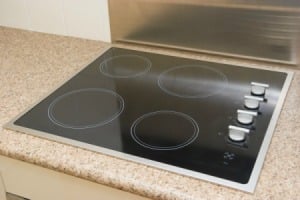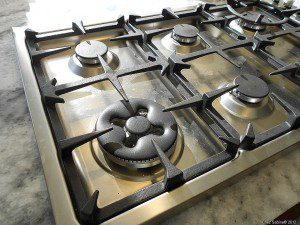The Dirty Glove: Stove Edition
Cleaning thoroughly, efficiently, and greenly is the name of the game here at the Purple Fig, but we all have those areas of the house that- let’s face it -nobody likes to tackle. What better way to honor those dastardly, dirty crevices then to dedicate a post about how to scrub them until they shine?
Every other month, we’ll walk you through guidelines tailored for each unique mess (greasy stovetop? Moldy tub? Sticky sink?) and lend some valuable tips along the way. So strap on your gloves, because we’re about to clean a regularly used and often neglected appliance in the house: the stove.
Tools you’ll need:
Spray bottle
Spray mix (a blend of water, vinegar, and lemon extract*)
Baking soda
Paper towels or cotton rags
Paint scraper/Scraper tool
Gloves
Understanding the Stove
Many people harbor a love-hate relationship with their stoves: on the one hand, it’s a bringer of feasts and a gathering place for family and friends; on the other, it’s a graveyard for food scraps, stains, and grease. The average person cooks on the stove at least once a day…and by the end of the workweek, if not properly maintained, the stove top can seem untamable. And if untouched for months? It can get downright demonic.
Even if you clean up after every meal- which is highly recommended -a cursory swipe won’t always disinfect the entire surface area, and it definitely doesn’t account for the overlooked grooves and crevices built into the appliance. So let’s become intimately acquainted with our stove tops, and show them the love they deserve!
For the Traditional Porcelain Stove
First we’ll tackle the classic porcelain stove top, in all of its glory. Usually porcelain stoves have burner coils and drip pans, but these tips can be applied to gas burners as well:
1. First, take your spray bottle and fill it with water, vinegar, and lemon extract (*the extract is optional, but leaves a wonderful aroma). The ratio of water to vinegar depends on the state of the stove in question, but half and half is a good gauge. For a less vinegar-laden smell, make it a 3/1 water to vinegar ratio, and/or toss in a couple of squirts of extract.
2. Remove the coils by gently tugging them out of their plugs. Place them aside, and remove the drip pans as well (these probably contain crumbs and ash from burnt food scraps, so be careful not to spill them!).
3. Now that your stove is bare, observe which spots need the most attention. Is there grease on the backsplash? Grime rings that were hidden under the pans? Stains or spills in general? Take your spray bottle and give the entire stove top area a generous spraying. Let it sit.
4. OPTIONAL: If your stove top lifts up (to check, try grabbing the edge of the stove, typically near the knobs, and pulling upward) then check “under the hood”. A normal stove will collect a hefty amount of food bits in this area, so either use a small vacuum or wet paper towel to suck/wipe up these stragglers.
5. Sprinkle a layer of baking soda onto the surface of the moistened stove top. Let it sit for a few minutes, then wipe off with rag or paper towel. This will remove a majority of the crumbs and debris.
6. Spray the stove top at will and firmly scrub any problem area left over, paying special attention to stubborn grime rings. For caked on grease, take your *citrus solution and spray the areas generously, immediately wiping clean. For chunks of hardened food that won’t budge, take your scraper (this can be a plastic paint scraper or any blunt blade) and dig in under the mess until the food separates from the stove.
7. For heavy duty detox, remove your stove knobs and scrub the hidden area behind them. Clean your stove knobs before replacing them as well.
8. Wipe the stove top one last time, to remove any re-settled particles.
Voila! With a few repetitions of these steps, your porcelain will shine up like a new penny! For tips on how to naturally clean your drip pans, visit Frugality Gal’s tutorial here!
For the Modern Electric/Glass/Ceramic Stove
Adored for its easy breezy design, cleaning glass-ceramic stove tops requires the least amount of effort.
1. First, take your spray bottle and fill it with water, vinegar, and lemon extract (*the extract is optional, but leaves a wonderful aroma). The ratio of water to vinegar depends on the state of the stove in question, but half and half is a good gauge. For a less vinegar-laden smell, make it a 3/1 water to vinegar ratio, and/or toss in a couple of squirts of extract.
2. Take your solution and give the entire stove top area a generous spraying. Let it sit.
3. Sprinkle a layer of baking soda onto the surface of the moistened stove top. Let it sit for a few minutes, then wipe off with rag or paper towel. This will remove a majority of the crumbs and debris.
4. Spray the stove again and firmly scrub any problem area left over, paying special attention to stubborn grime rings. For caked on grease, take your *citrus solution and spray the areas generously, immediately wiping clean. For chunks of hardened food that won’t budge, take your scraper (this can be a plastic paint scraper or any blunt blade) and dig in under the mess until the food separates from the stove. Be careful not to scratch the surface.
5. For heavy duty detox, remove your stove knobs and scrub the hidden area behind/underneath them. Clean your stove knobs before replacing them as well.
6. Wipe the stove top one last time, to remove any re-settled particles.
For the Sleek Stainless Steel Stove
The stainless steel stove is an enigma, seeing as it is both easier and more difficult to clean in comparison to the other stove types. Since stainless steel stoves typically have gas burners, there is no drip pan in the way of the grime…and yet the thick iron grates require a special scrubbing of their own.
1. First, take your spray bottle and fill it with water, vinegar, and lemon extract (*the extract is optional, but leaves a wonderful aroma). The ratio of water to vinegar depends on the state of the stove in question, but half and half is a good gauge. For a less vinegar-laden smell, make it a 3/1 water to vinegar ratio, and/or toss in a couple of squirts of extract.
2. Remove the grates and set them aside for now.
2. Give the entire stove top area a generous spraying, avoiding the gas burners as much as possible. Let it sit.
3. Sprinkle a layer of baking soda onto the surface of the moistened stove top. Let it sit for a few minutes, then wipe off with rag or paper towel. This will remove a majority of the crumbs and debris.
4. Spray the stove again and firmly scrub any problem area left over, paying special attention to stubborn grime (usually directly around the burners). For caked on grease, take your *citrus solution and spray the areas generously, immediately wiping clean. For chunks of hardened food that won’t budge, take your scraper (this can be a plastic paint scraper or any blunt blade) and dig in under the mess until the food separates from the stove. Be careful not to scratch the steel while doing so.
5. For heavy duty detox, remove your stove knobs and scrub the hidden area behind/underneath them. Clean your stove knobs before replacing them as well.
6. Wipe the stove top one last time, to remove any re-settled particles.
7. Stainless steel stoves exclusively use raw cast iron grates, which are not recommended to be soaked or submerged in hot water. Here are some tips:
- For raw iron grates, wash them in hot water and scrub them with eco-friendly dish soap.
- The vinegar solution can also be scrubbed onto them to tackle more stubborn stains.
- For extra punch, combine baking soda and water and scrub the grates thoroughly with the paste.
Last Minute Tips
- Always remember to check the crevices on each side of the stove, where the range meets the countertop. Food and grime get lodged in these areas and frequently get overlooked as well. Use your scraper to scrape away build up in these crevices.
- For porcelain enamel-coated grates, found with gas burners on any type of stove top, you can either wash them in the dishwasher (using eco-friendly dishwashing pods!), soak them in hot water and eco-friendly soap, scrub them with the vinegar solution, or use ammonia to fight off horrible stains. Check out The V Spot’s tutorial here!
Enjoy our now spotless stove, and remember: the best way to prevent unsightly stains is to clean your stove top regularly!



